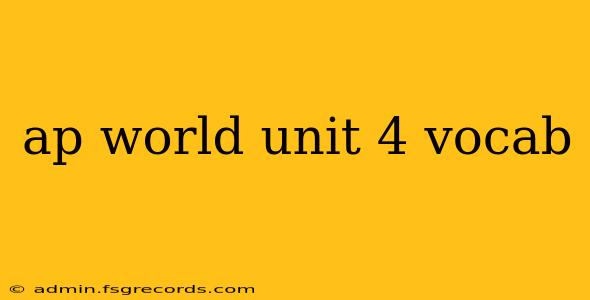Unit 4 of AP World History covers a pivotal period of global transformation, from 1450 to 1750. Mastering the vocabulary is crucial for success. This guide provides in-depth definitions and contextual understanding of key terms, ensuring you're well-prepared for the exam.
Key Terms and Concepts:
This section breaks down essential vocabulary into thematic categories for easier understanding and memorization.
Global Trade and Exchange:
-
Mercantilism: An economic policy where a nation's power is directly linked to its wealth, typically measured in gold and silver. Colonies served as sources of raw materials and markets for finished goods, maximizing the mother country's profits. This system fostered intense competition between European powers.
-
Columbian Exchange: The widespread transfer of plants, animals, culture, human populations, technology, diseases, and ideas between the Americas, West Africa, and the Old World in the 15th and 16th centuries. This exchange had profound and lasting impacts on both hemispheres, including population shifts, agricultural changes, and the introduction of new diseases.
-
Triangular Trade: A complex trade network connecting Europe, Africa, and the Americas. European manufactured goods were traded for enslaved Africans, who were then transported to the Americas to work on plantations producing raw materials (sugar, tobacco, cotton) that were shipped back to Europe. This system fueled the transatlantic slave trade and significantly shaped the economies of participating regions.
-
Joint-Stock Companies: Business ventures where investors pooled resources to finance exploration and trade, sharing both profits and risks. Companies like the Dutch East India Company and the British East India Company played significant roles in global trade, establishing monopolies and influencing colonial policies.
-
Commercial Revolution: A period of European economic expansion, colonialism, and mercantilism. This involved the growth of capitalism, new financial instruments (like banks and stock exchanges), and the expansion of trade routes.
Political and Social Structures:
-
Absolutism: A political system where a monarch holds supreme authority, unchecked by any laws or institutions. Examples include Louis XIV of France and Peter the Great of Russia, who centralized power and controlled all aspects of their states.
-
Constitutionalism: The principle of limiting governmental power through a written or unwritten constitution, emphasizing individual rights and representative government. While emerging in Europe during this period, it was not uniformly implemented.
-
Encomienda System: A labor system in Spanish colonies where Spanish conquistadors were granted control over indigenous populations, requiring them to pay tribute or work. This system was brutal and led to widespread exploitation and abuse.
-
Hacienda System: A system of large agricultural estates in Spanish America, often employing indigenous and African laborers. Unlike the encomienda, it focused on agricultural production and was more stable and enduring.
-
Manorialism (Decline): While originating earlier, the feudal manorial system continued to decline as centralized states gained power and commercial activities expanded.
Cultural and Religious Transformations:
-
Syncretism: The blending of different cultural or religious traditions. Examples include the fusion of indigenous beliefs and practices with Christianity in colonial societies, resulting in new religious expressions.
-
Reformation: A religious movement that began in Europe in the early 16th century, challenging the authority of the Catholic Church. The Reformation led to the emergence of Protestantism and significantly reshaped the religious landscape of Europe and beyond.
-
Counter-Reformation: The Catholic Church's response to the Reformation. It involved internal reforms (Council of Trent) and the establishment of new religious orders (Jesuits) to combat the spread of Protestantism.
Technological Innovations:
-
Printing Press: Johannes Gutenberg's invention revolutionized communication and knowledge dissemination, contributing to increased literacy and the spread of new ideas, including religious reform.
-
Caravel: A small, highly maneuverable sailing ship that played a significant role in European exploration and trade during the Age of Exploration.
This vocabulary list provides a solid foundation. Remember to delve deeper into each term, understanding its context, historical significance, and connections to other concepts within Unit 4. By mastering this vocabulary, you'll be well-equipped to analyze primary and secondary sources and effectively answer exam questions. Remember to consult your textbook and other reputable resources for further information.

